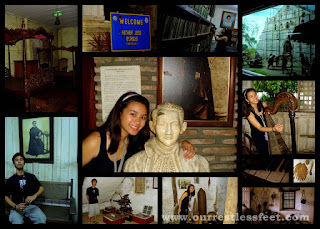
WHERE: Padre Burgos Museum, Vigan, Ilocos Sur
DATE OF TRAVEL: September 21-23, 2007
WHY YOU SHOULD GO:
1) The Padre Burgos Museum, built in 1788, is the ancestral home of the Philippines' martyr-priest Father Jose Burgos.
2) It is one of the last few remaining Spanish-era houses in the country with most of its' original furniture still intact.
3) It contains a collection of Burgos family photographs, jewelries, antiques and memorabilia which includes a copy of Noli Me Tangere, written by a student of Father Burgos - Jose Rizal, which was given to Father Burgos as a gift.
4) The museum also contains dioramas of local history and displays of Ilocano and Tinggian archeological artifacts.
5) There are 14 paintings by Esteban Villanueva depicting the events during the 1807 Basi Revolt.
FEES: P10 entrance fee
DESCRIPTION: Built in 1788 by the grandparents of Father Jose Burgos, Don Juan Gonzales and Dona Florentina Gascon, the ancestral house still stands intact with most of of its original furniture.
Father Burgos was born in this house in 1837, he started his studies in Vigan and then continued in Manila in San Juan de Letran and the University of Santo Tomas. During his priesthood, he exemplified courage by fighting the Spanish friars for equal rights for the Filipino clergy. Because of this he was marked by the Spanish and he was later tried and executed along with two other martyr priests, Father Gomez and Father Zamora. The three were known as the GOMBURZA martyrs, they served as an inspiration to the Filipino revolutionaries. Jose Rizal's second novel, El Filibusterismo, was dedicated to Father Jose Burgos. The novel was written after the execution of the GOMBURZA.
In the museum, you will also find 14 paintings by Esteban Villanueva depicting the Basi Revolt. In 1786, the Spanish colonial government took over the manufacturing and sale of the Ilocanos beloved basi, sugarcane wine. The private manufacturing of the wine was banned by the Spanish which forced the Ilocanos to purchase the wine that they make from government stores. On September 16, 1807, the Ilocanos rose up in revolt which lasted for weeks. Eventually, the Spanish government was able to subdue the revolution with much casualties.
HOW WE GOT THERE:
By private bus: From Manila, we joined a field trip and headed up north via a hired bus.
On our second trip, we traveled from Baguio to Vigan and got there in 4 hours via a private vehicle. Partas Bus Lines also ply the Baguio-Vigan route for about P230 per head.
Once in Vigan, just hail a tricycle and ask the driver to take you to the Padre Burgos Museum. It is also just walking distance from Plaza Salcedo and Calle Crisologo.
PUBLIC TRANSPORTATION:
Airconditioned Buses leave from Manila to Vigan daily. The trip takes about 8-9 hours. For a list of buses, click this.
You can also fly for an hour from Manila to Laoag City via Cebu Pacific, Philippine Airlines or Zest Airways. From Laoag, you can take a bus to Vigan City. The trip takes about 1.5-2 hours.
Tuesday, September 25, 2007
Padre Burgos Museum, Vigan, Ilocos Sur
Subscribe to:
Post Comments (Atom)
-2.jpg)


Thank you for this information, it's very complete and straight to the point. Thank youuu
ReplyDeleteI love travelling and you guys inspired me more. I find your blog very helpful and easier for me to plan where and what I want to see. Bookmark :)
ReplyDelete